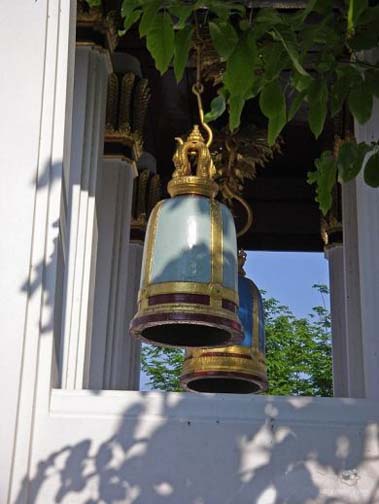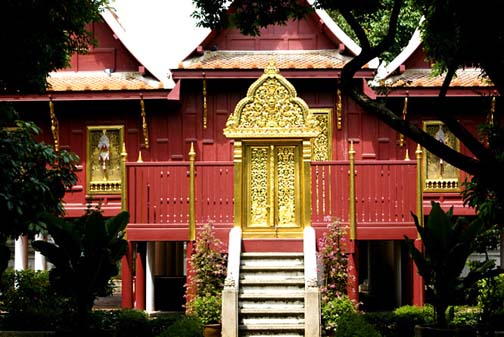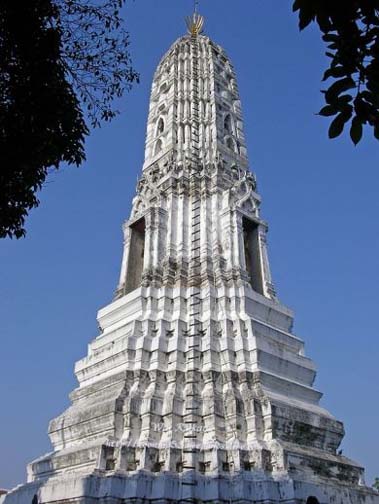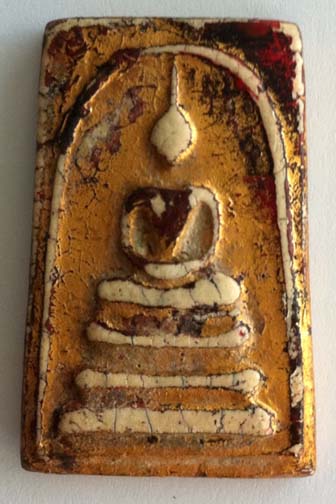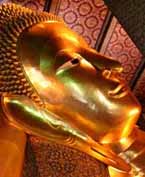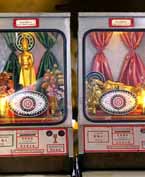
Wat Rakang may not look like much from the Chao Phraya River, but that’s because your eyes are usually drawn to its neighbor, Wat Arun, instead.
It’s difficult to not be impressed with Wat Arun with its porcelain shard covered prang facade reaching into the sky as you motor up the Chao Phraya. It’s second only to Phuket for having a name that’s fun to pun around with too. And from Tha Chang Pier, it’s a crap shoot for most visitors whether figuring out how to get across the river for a visit or heading inland for an attempt at finding the Grand Palace not closed will be the easier endeavor. Either site works well if you are into crowds. But if a wat is wat’s up for your day and you want some significance out of your visit you may want to visit Wat Rakang Kositaram instead. Or Wat Rakang Kositaram Woramahawihan if you are pedantically inclined. Or Wat Rakang if you are not into details. It’s easy to find. Just look for Wat Arun and then look down. Locals know it is the temple to head for when your reputation needs some PR work. And considering what you probably did in Patpong last night, your rep undoubtedly needs a good dose of Wat Rakang’s magic too.
Wat Rakang’s claim to fame for helping you clean up yours is just one of its draws. That one is due to its name (The Temple of the Bells) and the belief that worshiping at the wat will result in you becoming popular and having an ever-growing reputation just like the far-reaching sound of ringing bells. Just outside the temple there is even a row of bells lined up. It is believed that ringing all of them in sequence will bring you good luck. But that depends on how you define luck. The temple’s fame comes from a large bell that was unearthed there during renovations in the 1700s when King Rama I reigned supreme. It was a cool bell. So he had it floated across the river and installed at the Temple of the Emerald Buddha in his palace, a swap he made for five smaller bells for the wat. So if you are a fan of quantity over quality, Wat Rakang is for you. Which brings us back to what you were probably up to in Patpong last night and why you really need to visit Wat Rakang today.
Undoubtedly, your soul is in bad need of making some merit and since locals in Thailand are always in bad need of some baht even before you make it to those bells your wallet can participate in various important Buddhist religious rites. Because just as anywhere in the world those fresh off the boat make for easy marks, at the Wat Rakang Pier you can buy food to throw at the massive school of catfish who greedily await your arrival. (There’s also a massive flock of pigeons greedily waiting to steal the bread you bought for the fish, but pretend they are usurpers from Burma and ignore them.)
Nearby, the aforementioned locals greedily await your arrival too and are willing to sell you a baby turtle or two to release into the Chao Phraya. Both of these activities are considered ways to make merit. I have to assume, being similar, that releasing your boy du jour to return to his gogo bar is a merit making activity too. But then if you took him temple touring with you today, he’s probably just glad you visited Wat Rakang instead of its neighbor, Wat Arun, and he didn’t have to help drag your tired ass up that wat’s prang’s steep, seemingly never-ending, narrow steps.

Because Thais love nothing more than beating a joke to death, King Bhumibol gave Wat Rakang some bells too.
Wat Rakang was built during the Ayutthaya period and was originally known as Wat Bangwayai. Because those five little bells Rama I tried to pawn off for the cool big bell he coveted weren’t quite enough, he also gave the wat a new name. Uh, that’d be Wat Rakang. ‘Cuz rakang is the Thai word for bell. Supposedly the wat got its moniker of The Temple of the Bells in honor of the discovery of that big ‘un, but when you are king you can do whatever you want, including grabbing the best souvenirs, and I suspect Rama I just wanted to throw some shade and give the temple a lasting reminder of what happens when you horse-trade with royalty. It’s kinda become a royal family joke. A pair of blue bells, which you can see in front of the temple’s ubosot, were more recently gifted to the temple by King Bhumibol (aka Rama IX). Those Ramas are such jokesters.
As if the bell thingy wasn’t enough, Rama I also built a rather grand residence just across the river from Wat Rakang (that’d be the Grand Palace) just so his former domicile could always have a reminder of the difference between being a king and a king-to-be staring it in its face. Before his enthronement, #I used to live at Wat Rakang. He ‘donated’ his former digs to the wat, headed off to war, and returned a king with a snazzy new place to call home. His former digs were torn down and then reconstructed by the pond behind the temple’s ubosot, not so coincidently in the spot where that damn bell was found. It’s been since moved again (‘cuz the royals just can’t resist fucking with Wat Rakang) and is now known as the Tripataka Hall, a monastic library, or Ho Trai, where the wat’s ancient Buddhist scriptures are kept (or at least those some Rama hasn’t moved across the river) and its once vividly painted red exterior walls are one of the temple’s most photographic sites.
But wait! There’s more! #I and his elder sister – who also wanted to get in on the act – had a Khmer-style prang built at Wat Rakang too, which Prince Naris – who is widely recognized as one of Siam’s greatest artists – deemed the most perfect Rattanakosin prang in Thailand. Wat Rakang’s prang is regarded as the prototype of prangs in the present era. Which finally sounds like Wat Rakang got some of the props it deserved. But as perfect as its prang may be, Wat Arun’s is a hell of a lot bigger (and more famous, rightly so) and we all know that with prangs as with most things, size matters. But I guess that does make Wat Rakang’s prang the quintessential Asian prang in Thailand. Or as the Chakri Dynasty clan like to joke when they sail by: “Oh look! It looks just like a prang. Only smaller.”
Now with Wat Arun almost next door, visiting Wat Rakang may start sounding like that time your parents promised you a trip to Disneyland and only took you to Universal Studios instead, but the whole point of rewarding international travel is the cool souvenirs you can take home to remind your friends and family of how much richer and more fulfilled your life is. And when it comes to Mickey Mouse ears in Thailand, nothing beats a powerful Buddhist amulet. Sure, you can find lots at the Mahathat Amulet Market over by the House That Rama I Built, but even Thai royalty won’t mess with Buddha bling and true believers know when it comes to luck, love, protection, and good fortune, Wat Rakang is the place to be. Unless you are a bell. Obviously.
There are a lot of Buddha amulets in Thailand but there are none so famous and sought after as Pra Somdej Wat Rakang made by Somdej Pra Puttajarn Toh Prommarungsee, or Archarn Toh or Somdej Toh for short. He was a son of King Rama II (before he became the King) and as pre-king royals in Thailand often do took the vows of monkhood at the age of 13. Unlike some, he stuck to it, probably because with 73 siblings his chances of becoming Rama III were pretty slim.
By the age of 21, he obtained senior monk status as well as the affectionate nickname Maha Toh, or King’s monk. And by the reign of Rama IV (aka King Mongkut, aka the titled character in The King And I) Maha Toh received the ultimate title of Somdej Phra Puttajarn Toh, the highest level of monkhood. Having scaled the monkhood peak and having put that whole bell thingy behind him, Somdej Toh found himself with lots of free time on his hands and took up amulet making as a hobby. Due to the old-timey methods he used – which imparted great power to his hand crafted pieces – these amulets became very famous and were called Somdej Wat Rakang, and/or Phra Somedej.
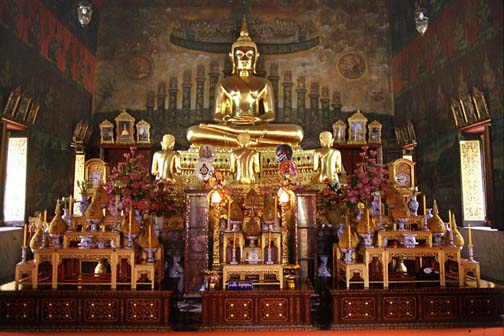
Wat Rakang’s presiding Buddha image is known as Phra Prathan Yim Rap Fa, but its power is overshadowed by the temple’s famous Phra Somdej amulets.
In his life time, Somdej Toh made around 84,000 Phra Somdej amulets. Today they fetch extremely high prices. Like in the millions of baht. Or, as a honored visitor to Wat Rakang, assuming you earned lost of merit feeding catfish and setting turtles or bar boys free, you too can buy a genuine Phra Somdej amulet right where it was made for a mere hundred bucks or so (so being the Thai word for however much you are willing to pay). Sure you can buy them on eBay and Amazon too, but while those may come with a genuine Certificate of Authenticity, just like when buying Mickey Mouse ears, it means so much more when you buy them from the mouse himself.
How powerful are Phra Somdej amulets? Back in 2008, a police officer in Pattaya got busted and charged for robbery and attempted murder when he tried to steal one, then estimated at a value of 8 million baht, from its owner. The Boy in Brown pointed his gun at the amulet owner’s head and pulled the trigger twice. But the gun failed to fire. And while guns that fail to fire in Pattaya are usually blamed on shoddy, knock-off Viagra, in this case it was the protective powers of the Phra Somdej amulet that got the props.
The making of Phra Somdej amulets continued after his death, using the original five molds Somdej Toh made. Kinda, sorta. As an amulet maker he may have reigned supreme, as a mold maker, not so much. His sucked. So the king’s goldsmith made new ones. And then proceeded to mass produce the one-of-a-kind collectibles. But having learned their lesson with that bell thingy, the powers that be at Wat Rakang did not sit idly by while those bastards across the river hauled in all the loot and began offering new limited-edition amulets directly from where Somdej Toh once lived (limited-edition being Thai for as many as they could sell). That practice continues today and a new amulet is released whenever a significant and/or auspicious event occurs at Wat Rakang.
(Wat Rakang is open daily from 8am to 5pm; admission is free, but fake amulets are not. Take the Chao Phraya River Express Boat to Tha Chang Pier, hop off and then take a ferry to cross the river to the Wat Rakang Pier.It’s about a five minute walk from making merit by feeding the catfish to Wat Rakang.)
| Related Posts You Might Enjoy: | ||

